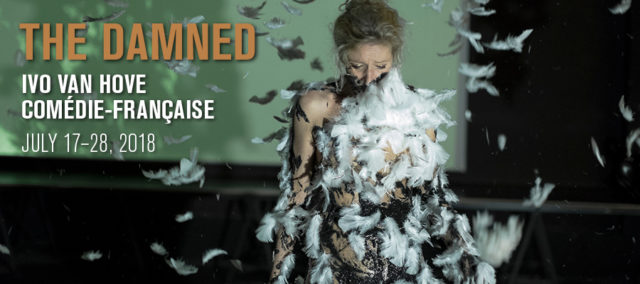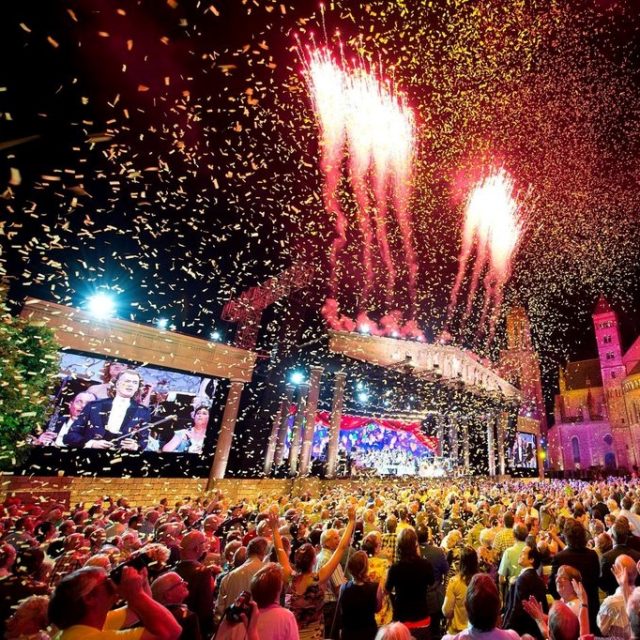Ivo van Hove “The Damned”

”The Damned” at Park Avenue Armory(armorypark.org)
I had the opportunity to go see two superb performances this year by two of today’s most impressive directors: the first was the revival of Tony Kushner’s “Angels of America” directed by Marianne Elliot, and the other was Ivo van Hove’s “The Damned”, an adaptation from Luchino Visconti’s film of the same title. While I’d love to write about both plays, I will stick to the latter, which I saw more recently at the Park Avenue Armory in New York. This was by far one of the best performances I have ever seen.
Visconti’s “The Damned” was one of my favorite films for a long time. Many of Visconti’s films have a (homo-)erotic tinge that was one aspect I think I was attracted to (he also directed “Death in Venice”), and he chose actors such as Dirk Bogart, Helmut Berger and Alain Delon in his films – actors who had an aura of illicitness that was irresistibly attractive.
“The Damned” – play vs. film
I dare say Ivo van Hove’s “The Damned” was even better than the film. One of the many stunning aspects of the performance was the use of filming during the play — the filming became a mise en scene, making the connection with the original format. The stage itself was divided into three sections, and a screen put up at the upstage area became a “fourth section” of the stage. The filming was a mixture of live and prepared filming. The live filming was conducted by a videographer following an actor or a group of actors on the stage, usually filming them in close up, with those visuals projected onto the screen on the stage simultaneously. The visuals projected on the screen were so compelling, and for me, added an emotional intensity to what was going on the stage. Also, what was happening on the stage, as well as on the screen, were visually stunning. The acting was superb, by the Comedie-Francaise, performing in French (with supertitles on stage).
“The Damned” is about how a prominent industrialist family is affected by and deals with the rise of Nazism in Germany; at a deeper level, it is about “ideological debauchery of a society ready to make the most venomous alliances for the benefit of its sole economic interests” (sound familiar?). Van Hove first staged “The Damned” at the Avignon Festival in the summer of 2016, presaging the Trumpian era.
Who is Ivo van Hove?
Ivo van Hove is a Belgian director who was born in 1958, and is Toneelgroep Amsterdam (the largest repertory theater in the Netherland)’s General Director – while engaging in multiple theater productions around the world. He started work in theater at boarding school. In an interview with The New Yorker, he said he felt boarding school was “a walled world within the world, and the theatre was another walled world within it. That felt so warm, so good.” He also said that once the rehearsal-room door was closed, “everything is allowed – I can express every fantasy and obsession. It is total freedom of your mind, of your life.” He then went to law school but quit school in his third year of studies, and transferred to an art school in Antwerp to study theater directing, upsetting his parents (he also came out as gay to his parents). At art school, he met his life-long partner and collaborator, Jan Versweyveld (who did the lighting and sound for “The Damned”).
“The Damned” is not the first Luchino Visconti film van Hove staged on theater; he has also staged “Rocco and His Brothers”, “Obsession” and “Ludwig”. Van Hove says he bases his productions on the screenplays, and not on the movie itself (even if he might have seen the film years ago). When he started out as a director, he used to write his own material but he says that he finds that he could express himself better by adapting other existing material.
In 2015, I saw van Hove’s “View from the Bridge”, an Arthur Miller play for which van Hove won both the Olivier and Tony Awards. To be honest, other than the staging, I didn’t like the performance, so I didn’t go see “The Crucible”, another van Hove play that was also on Broadway at the time. But now, I will definitely seek out van Hove’s projects. Excitingly, van Hove’s next project for Broadway is “West Side Story”, which he will collaborate with fellow Belgian and avant-garde choreographer, Anne Teresa De Keersmaeker, whose dance I was privileged to see being rehearsed at the Tate Modern in London a number of years ago. I love “West Side Story” and will be very curious to see how van Hove and De Keersmaeker will re-interpret the classic.
Born in Yokohama, Japan. Went to an international school in Yokohama, then to university in Tokyo and graduate school in London. Worked at the United Nations since 1991, both at the headquarters in New York and several peacekeeping operations (Cambodia, Bosnia and Herzegovina, East Timor and Sudan).


